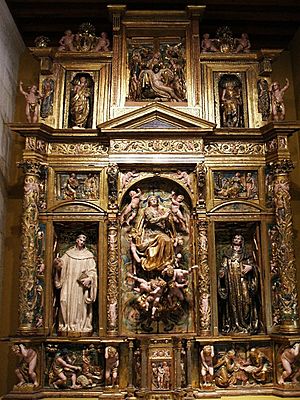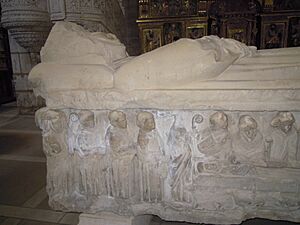Urraca López de Haro facts for kids
Urraca López de Haro (born around 1160, died about 1230) was an important noblewoman in medieval Spain. She was the daughter of Count Lope Díaz de Haro, a powerful lord, and his wife Aldonza. Urraca became Queen of León from 1185 or 1187 to 1188 when she married King Ferdinand II. She later founded a special place called the Monastery of Santa María la Real in Vileña, where she lived out her final years and was buried.
Contents
Early Life and First Marriage
Urraca first married a nobleman named Nuño Meléndez around 1180. He was related to her mother's family. Not long after, around 1182, Urraca became close with King Ferdinand II. This happened after his second wife, Teresa Fernández de Traba, passed away.
Becoming Queen of León
Urraca and King Ferdinand II married a few years later, in May 1187. The King gave her several properties in places like Aguilar and Monteagudo. As the King grew older and weaker, Urraca tried to make sure her son, Sancho, would become the next king. She wanted him to be king instead of Alfonso, who was King Ferdinand's son from his first marriage. Urraca argued that Alfonso was not a rightful heir because his parents' marriage had been cancelled. It seemed Urraca's plan worked for a while, as King Ferdinand sent his son Alfonso away from the court.
Life After the King's Death
King Ferdinand II died on January 22, 1188. His first son, Alfonso IX, became the new King of León. After this, Urraca had to find safety in the Kingdom of Castile. This kingdom was ruled by King Alfonso VIII, who was her former husband's nephew. Urraca asked her brother, Diego López II de Haro, to protect her lands in León.
However, King Alfonso IX of León was worried about how powerful the Haro family was. He made a deal with King Alfonso VIII of Castile. Then, King Alfonso IX attacked the castles and lands that Urraca owned in León.
In 1213, a count named Álvaro Núñez de Lara gave Urraca some land. He was married to Urraca's niece, Urraca Díaz de Haro. With these lands, Urraca founded the Monastery of Santa María la Real in Vileña in 1222. She put the Cistercian nuns in charge of running it. Even though Urraca did not lead the monastery as an abbess, she became a nun there. She was buried in a stone tomb inside the monastery church. This tomb was later moved to the Museum in Vileña after a fire in 1970. It was then moved again to the Museum of Burgos.
Some people have mistakenly thought that Queen Urraca was the abbess (the head nun) at the Monastery of Santa María in Cañas. But old records show that it was actually her niece, Urraca Díaz de Haro, who was the abbess there.
Urraca in Historical Records
Urraca's life is mentioned often in old historical documents:
- In August 1183, King Ferdinand II gave Urraca land in Villamor, Burón, and Omaña.
- On July 1, 1190, King Alfonso VIII of Castile gave Urraca the towns of Vileña, La Vid de Bureba, and Villaprovedo. He also gave her royal properties in Besga and Pedralada.
- On February 2, 1194, Queen Urraca confirmed that the Monastery of San Salvador de Oña owned the hills of Piedralada. King Alfonso VIII had given these hills to the monastery a year before. Urraca stated she did this "for the love of my brother Diego." Her son Sancho and her brother Diego also confirmed this gift.
- In 1195, Queen Urraca, along with her children Sancho and María Núñez, gave land in Mahude to a monastery.
- On April 15, 1222, as King Ferdinand II's widow, Urraca gave all her properties in Vileña and twelve other places to the nuns at the Abbey of Santa María la Real de Las Huelgas. She did this for her own soul and the souls of her children. These properties were added to her earlier gift for founding the monastery in Vileña. Elvira García became the first abbess there.
- On May 10, 1224, Pope Honorius III sent a document to Queen Urraca, who was "already a nun in this monastery." The document also addressed the religious community. It placed the monastery and its people in La Vid and Villaprovedo under the Pope's protection. This is the last time Urraca is mentioned at this monastery.
Family and Children
Urraca had one daughter with her first husband, Nuño Meléndez:
- María Núñez (died in 1255): She appeared with her mother and half-brother Sancho in 1195. They made a gift to the Monastery of Santa María de Trianos. María was not the abbess, but she temporarily managed the Vileña monastery that her mother founded.
She had three sons with King Ferdinand II:
- García Fernández (1182–1184): He was born before his parents were married.
- Alfonso Fernández (1184–1188).
- Sancho (1186/1187–1220): He inherited Monteagudo and Aguilar from his mother. In 1210, he married Teresa Díaz de Haro. She was the daughter of Diego López II de Haro, a powerful lord.
Where Urraca Was Buried
Queen Urraca was buried in a stone tomb. She was dressed as a nun with her hands folded. This tomb was first at the Monastery of Santa María la Real in Vileña, Burgos, which she had founded. The monastery is now in ruins. Her tomb is currently at the Museo del Retablo in Burgos. At the foot of her tomb, there is an inscription that says: "Doña Urraca, daughter of Count Lope Díaz, wife of King Fernando of León."
| Preceded by Teresa Fernández de Traba |
Queen Consort of León 1185/1187–1188 |
Succeeded by Teresa of Portugal |
See also
 In Spanish: Urraca López de Haro para niños
In Spanish: Urraca López de Haro para niños




